Are you ready to hit the trails and experience the thrill of mountain biking? Learning to mountain bike may seem daunting, but with the right tips and techniques, you can quickly gain confidence and start enjoying the sport. At our mountain biking center, we have helped countless beginners take their first pedal strokes and progress to more challenging trails.
In this guide, we will walk you through the fundamental skills, essential gear, and safety tips to help you become a confident mountain biker.
Key Takeaways:
- Learning to mountain bike takes time, practice, and patience.
- Knowing the fundamentals and having the right gear is crucial to success.
- Maintaining safety awareness and troubleshooting common issues can help prevent accidents.
Advertising links are marked with *. We receive a small commission on sales, nothing changes for you.
Understanding Mountain Biking Fundamentals
Before hitting the trails, it’s important to understand the foundational concepts of mountain biking.
First and foremost, mountain biking involves riding off-road trails and terrain, which can vary greatly in difficulty. As a beginner, it’s important to start with easier trails and gradually work your way up to more challenging terrain.
Another crucial element of mountain biking is bike handling skills. This includes proper body positioning, balance, and braking technique. It’s important to maintain a centered position over the bike, keeping your weight balanced between the front and rear wheels. When braking, use both the front and rear brakes together to avoid skidding or losing control.
Gearing is also an essential aspect of mountain biking. It’s important to understand how to properly shift gears to maintain a consistent cadence and conserve energy, especially when climbing hills.
Finally, it’s important to be aware of the natural environment around you. Many mountain biking trails pass through fragile ecosystems, and it’s important to stay on designated trails and avoid damaging the surrounding environment. Always pack out what you pack in, and be respectful of other trail users.
Fundamental Mountain Biking Skills
Beyond the foundational concepts of mountain biking, there are some specific skills that every beginner should work on. These skills include:
- Balance and stability: Practice riding with a centered body position and maintaining balance while navigating obstacles.
- Cornering: Learn how to properly lean into corners and maintain speed while turning.
- Descending: Practice keeping your weight back and your eyes focused down the trail while descending steep terrain.
- Climbing: Learn how to maintain a consistent cadence while climbing hills by shifting gears and controlling your breathing.
By focusing on these fundamental skills, you’ll be well on your way to becoming a confident and competent mountain biker.

Essential Mountain Biking Equipment and Gear
If you’re planning to hit the trails on a mountain bike, it’s important to have the right equipment and gear to ensure your safety and comfort. Here are some essential items you’ll need:
Bike
Your bike is the most important piece of equipment for mountain biking. Choose a bike that fits you well and is designed for off-road use, such as a mountain bike, fat bike, or trail bike. Look for a model with front and rear suspension to absorb bumps and shocks along the way.
Helmet
A helmet is a must-have item for mountain biking. It should fit snugly on your head and have a chin strap to keep it in place. Look for a helmet that is certified by the Consumer Product Safety Commission (CPSC) or other recognized safety organization.
Protective Gear
In addition to a helmet, you may want to consider other protective gear, such as knee and elbow pads, a chest protector, or a full-face helmet. These items can provide extra protection in case of a fall or collision.
Clothing
Choose clothing that is comfortable and breathable, such as moisture-wicking shorts and shirts. You may also want to wear gloves to protect your hands and improve grip on the handlebars. Don’t forget to wear closed-toe shoes or hiking boots with good traction.
Tools and Accessories
Carry a small toolkit with you for basic repairs on the trail, such as a tire pump, multitool, and spare tube. Other useful accessories include a water bottle or hydration pack, bike lights for night riding, and a GPS or map for navigation.
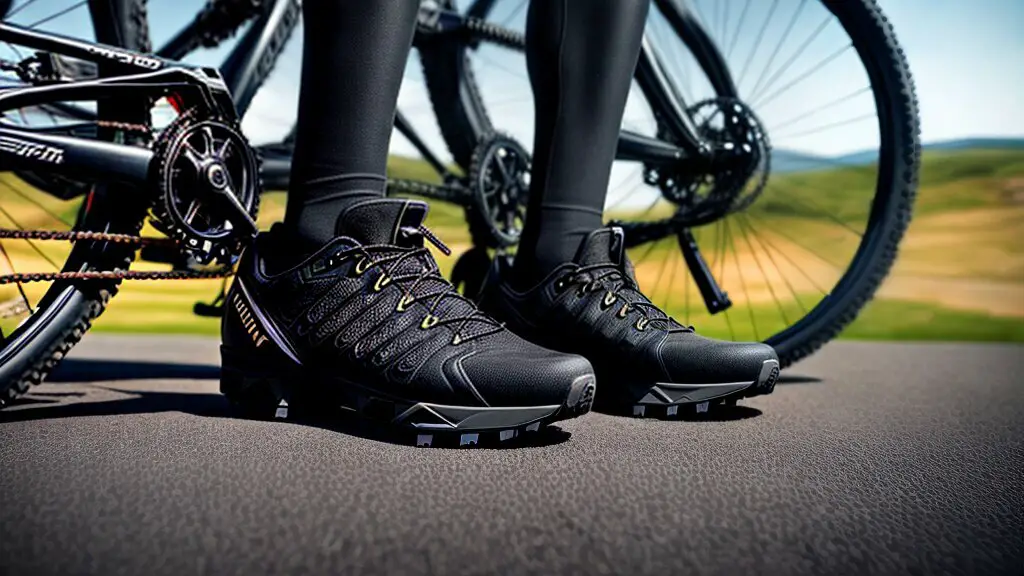
Investing in quality equipment and gear will not only improve your performance on the trail but also ensure your safety. Get geared up and get ready for an exciting ride!
Building Your Mountain Biking Fitness
Mountain biking requires a high level of physical fitness to handle the challenging terrain and long rides. As beginners, it is crucial to build your fitness gradually, to avoid injuries and burnout. We’ve compiled a few tips to help you get started:
Start Slow
Don’t try to become a pro mountain biker overnight. Begin with short rides on flat terrain to build your endurance and stamina. Gradually increase your distance and intensity over time.
Engage in Cardiovascular Exercises
Mountain biking requires strong cardiovascular endurance. Engage in activities like running, hiking, or cycling on flat terrain to build your endurance and stamina. These exercises help to strengthen your lungs and heart, enabling you to perform better on the trails.
Strength Training
Incorporate strength training exercises into your routine to improve your power, balance, and stability. Focus on exercises that target your legs, core, and upper body. Squats, lunges, planks, and push-ups are excellent exercises to include in your routine.
Cross-Training
Cross-training involves incorporating other activities into your routine to improve your overall fitness. Swimming, yoga, and Pilates are excellent low-impact activities that improve your flexibility, balance, and coordination.
Nutrition and Hydration
Eating a balanced diet and staying hydrated is essential for building your mountain biking fitness. Consume nutrient-rich foods and drink plenty of water to keep your body energized and hydrated during your rides.
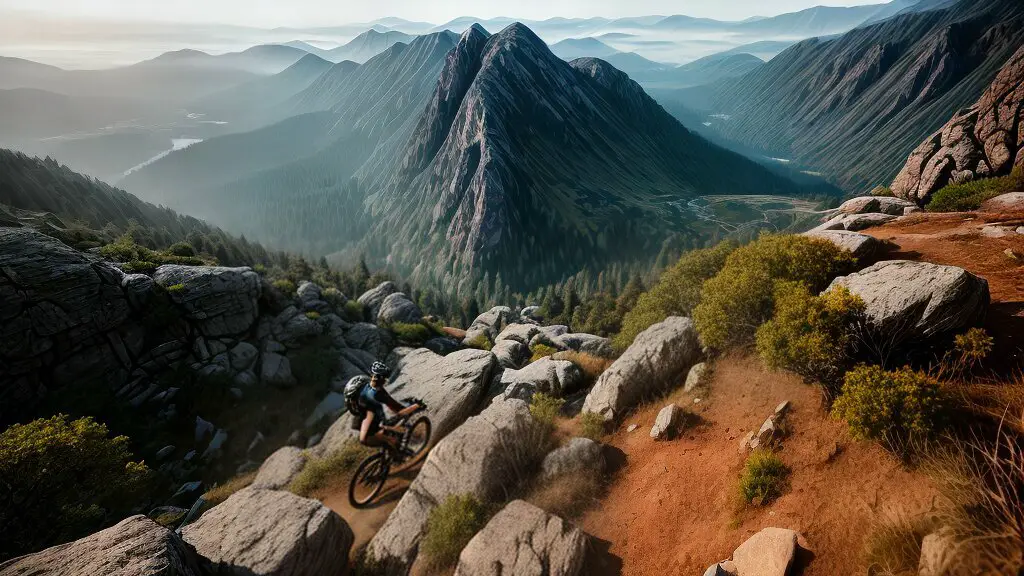
Workout type | Frequency | Duration |
|---|---|---|
Cardiovascular | 3-5 times a week | 30-60 minutes per session |
Strength Training | 2-3 times a week | 30-45 minutes per session |
Cross-Training | 1-2 times a week | 60 minutes per session |
Remember to listen to your body and take breaks when necessary. Building your mountain biking fitness takes time and effort, but it’s worth it in the end. With patience and consistency, you’ll be able to tackle even the most challenging trails.
Mastering Basic Mountain Biking Techniques
Now, let’s delve into the basic mountain biking techniques that every beginner should learn.
Riding Position
One of the most important techniques to master is your riding position. You want to maintain a relaxed, balanced, and upright position on the bike. Keep your feet level and your knees bent, with your weight towards the back of the bike. This will help you to absorb shocks and maintain control.
Braking
Another key skill to learn is braking. You want to use both your front and rear brakes simultaneously to slow down, but never jam them on too hard. Gradually squeeze the levers instead of grabbing them, and keep your weight back to avoid flying over the handlebars.
Shifting Gears
Shifting gears can also take some practice. You want to shift before you reach a hill or obstacle, and use your gears to maintain a steady cadence (pedaling speed). Shift to a lower gear for climbing and a higher gear for descending.
Climbing
Speaking of climbing, you should maintain a steady pace and avoid standing up on the pedals unless necessary. This will conserve your energy and help you maintain traction. Try to keep your upper body still and your pedals level.
Descending
When descending, keep your weight back and your body loose to absorb shock. Look ahead and anticipate obstacles, and use your brakes to control your speed. Keep your feet level and your knees bent, and shift into a lower gear if necessary to maintain control.
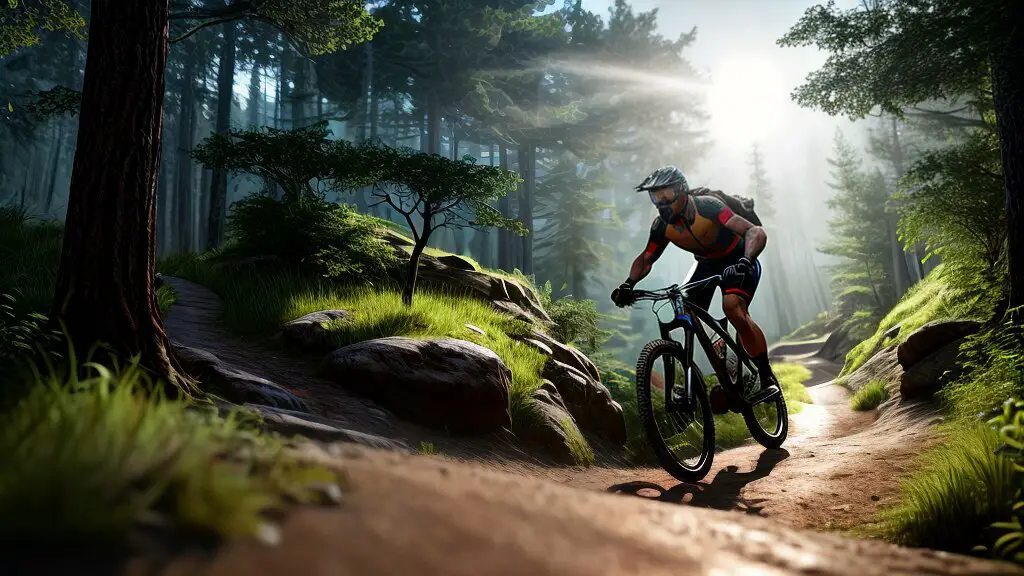
Using these techniques will help you feel more comfortable and confident on the trails. Remember to practice these skills in a safe environment before tackling more challenging terrain.
Developing Advanced Mountain Biking Skills
Once you have mastered the basic techniques of mountain biking, it’s time to take your skills to the next level. Developing advanced mountain biking skills can help you tackle more challenging terrain with ease, and make your rides even more exciting. Here are some tips and techniques to help you develop your skills:
| Technique | Description |
|---|---|
| Bunny Hop | The bunny hop is a technique that allows you to lift your front and rear wheels off the ground at the same time, allowing you to jump over obstacles such as logs or rocks in your path. To execute a bunny hop, begin by compressing your body and bike into a crouched position. Then, explosively extend your legs and arms while pulling up on the handlebars and pushing down on the pedals. The goal is to launch yourself and your bike into the air, clearing the obstacle with ease. |
| Manual | A manual is a technique that allows you to lift your front wheel off the ground and ride on your rear wheel only. This is useful for getting over obstacles such as roots and rocks, and can also be used for stylish maneuvers on the trail. To execute a manual, shift your weight towards the rear of the bike and lift up on the handlebars. Then, balance on your rear wheel while pedaling to maintain speed. |
| Cornering | Cornering is a technique that allows you to maintain speed and control while navigating tight turns on the trail. The key to successful cornering is to approach the turn with proper speed and body position. Enter the turn wide, with your outside foot down and your inside foot up. Lean your bike into the turn while keeping your body upright, and look through the turn towards your desired exit point. As you exit the turn, shift your weight forward and accelerate out of the turn. |
Remember, developing advanced skills takes time, practice, and patience. Start by practicing these techniques in a safe and controlled environment, such as an empty parking lot or a flat section of trail. As you become more comfortable, gradually increase your speed and tackle more challenging terrain. And don’t forget, always wear proper safety gear and ride within your limits.
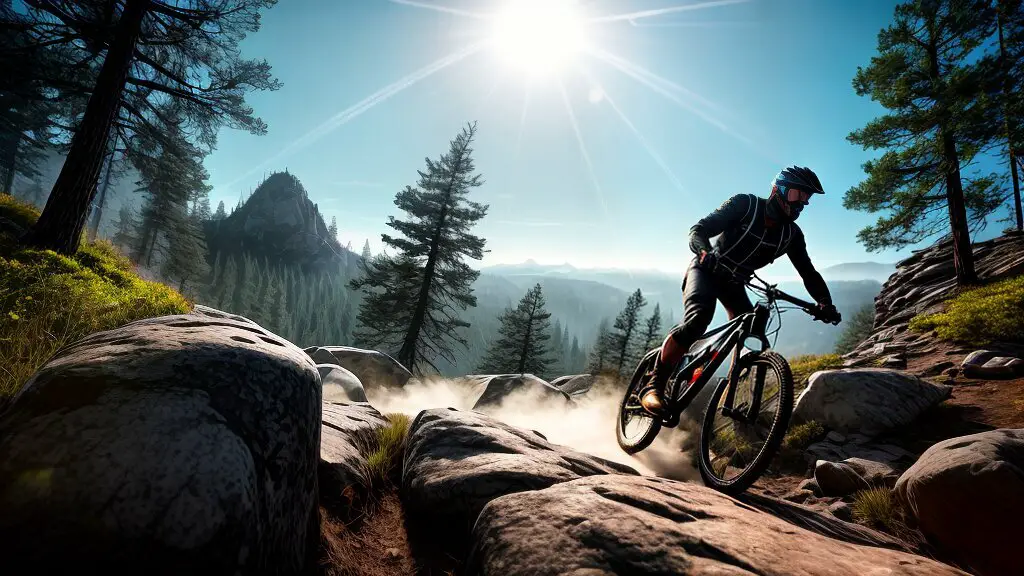
Exploring Mountain Biking Trails and Terrain
Now that you have a good understanding of mountain biking fundamentals, essential gear, and fitness, it’s time to take on some real terrain. Before hitting the trails, make sure to do some research on the area you plan to ride. Many trails have skill level ratings that reflect the difficulty of the terrain and are essential in helping you choose the right route.
Always start on beginner trails to gain confidence and improve your skills. These trails are typically wider, smoother, and have fewer obstacles and steep grades. As you progress, gradually move on to more challenging terrain.
Remember to always wear the appropriate gear, including a helmet, gloves, and protective clothing. Bring along plenty of water and snacks to stay hydrated and energized during the ride.
Trail Features to Look Out For
Mountain biking trails often have natural features that can add to the fun but also pose challenges. Here are some common features to look out for:
| Feature | Description |
|---|---|
| Berms | Banked curves that help you maintain speed and control |
| Rollers | Small hills that provide a fun and challenging terrain |
| Rock gardens | An area covered in rocks and boulders that require careful handling and navigation |
| Drops | Steep descents that require controlled speed and technique |
| Jumps | Ramps or bumps that allow you to catch air and perform tricks for the more advanced riders |
It’s important to approach these features with caution and ride within your skill level. Always scope out the feature before attempting it and visualize your line. And remember, it’s okay to walk your bike through sections you’re not comfortable with.
Exploring mountain biking trails and terrain can be an exhilarating experience, but always prioritize safety. Ride with a partner, let others know your route, and carry a first aid kit in case of emergencies. With practice and experience, you’ll soon be able to conquer any trail that comes your way.
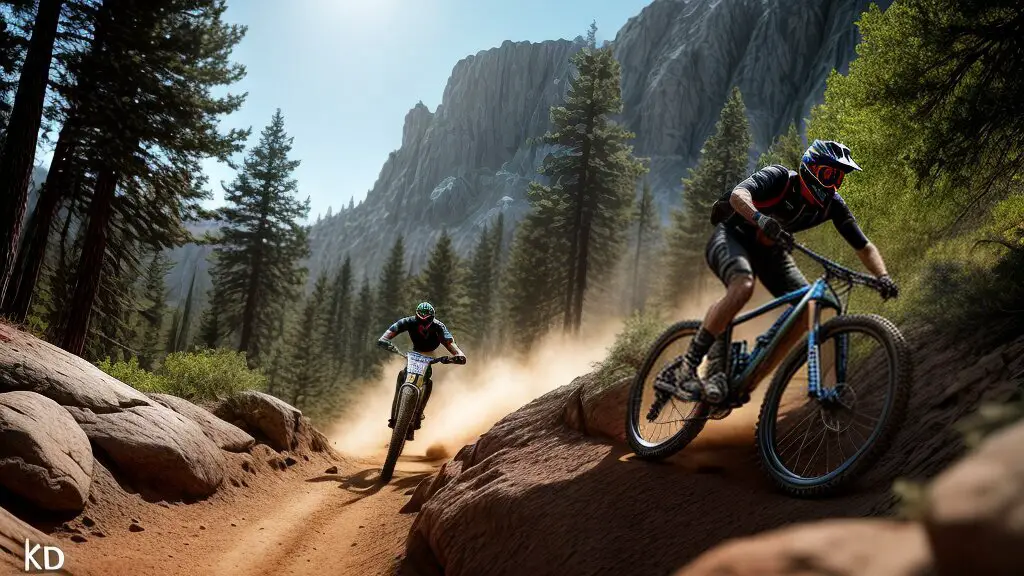
Joining Mountain Biking Classes and Tutorials
If you’re serious about learning to mountain bike, joining a class or tutorial can be an excellent way to acquire new skills, techniques and become a part of the mountain biking community. Many cycling stores offer introductory classes that teach you the basics of mountain biking, such as gear, safety and basic riding techniques.
If you’re looking to take your skills to the next level, consider joining an intermediate or advanced class. These classes are typically designed for riders who are comfortable on the mountain bike and can tackle more challenging terrain, jumps, and drops.
Another option to consider is hiring a mountain bike coach or professional instructor who can provide more personalized training. A coach will work with you one-on-one to help identify areas of improvement, focusing on specific techniques and skills to help you overcome obstacles and improve your riding experience.
Before you sign up for a class or tutorial, be sure to research different options and read reviews from past students to ensure you’re choosing a reputable instruction program.
Remember, mountain biking can be a thrilling, but also dangerous sport. It’s important to take your safety seriously and always wear the proper protective gear, including a helmet, gloves, and knee and elbow pads.
Joining a class or tutorial can help you learn and develop the skills you need to conquer any trail, but it’s up to you to practice and hone your abilities. So keep riding and enjoy the thrill of the outdoors on your mountain bike!
Safety Tips for Mountain Biking Beginners
Mountain biking is an exhilarating and challenging activity, but it can also be dangerous if adequate safety measures are not taken. As beginners, it is crucial for us to prioritize our safety and take all necessary precautions before hitting the trails. Here are some essential safety tips that every mountain biking beginner should know:
Wear Protective Gear
Prioritize your safety by wearing protective gears such as helmets, gloves, eye protection, and knee pads. These gears can protect you from injuries in case of falls or accidents. It is important to ensure that your protective gear fits perfectly and is appropriate for the type of mountain biking you are doing.
Check Your Equipment
Before embarking on your ride, it is essential to inspect your bike and equipment to ensure that they are in good condition. Check your brakes, tires, suspension, and chain to make sure that everything is in good working order. Make any necessary repairs or adjustments before heading out.
Choose the Right Trail
As beginners, it is important to choose a trail that fits our skill level and fitness level. Choose a trail that is marked as easy or beginner and gradually work your way up to more challenging trails as you gain experience and skill.
Ride with a Group
Riding with a group of experienced mountain bikers is an excellent way to learn and enhance your skills. Riding with others provides extra support and safety in case of accidents or emergencies.
Stay Hydrated and Nourished
Mountain biking is a physically demanding activity that requires a lot of energy and fluids. It is essential to stay hydrated and nourished throughout your ride to avoid dehydration and exhaustion. Carry enough water and snacks to keep your energy levels up during your ride.
Know Your Limits
Always ride within your limits, and don’t push yourself too hard. If you feel tired or are not comfortable with a particular aspect of the trail, slow down or walk your bike through it. It is important to know your limits and ride within them to avoid accidents and injuries.
By following these safety tips, we can ensure that our mountain biking experience is fun, challenging, and safe. Remember always to prioritize your safety and take all necessary precautions before hitting the trails.
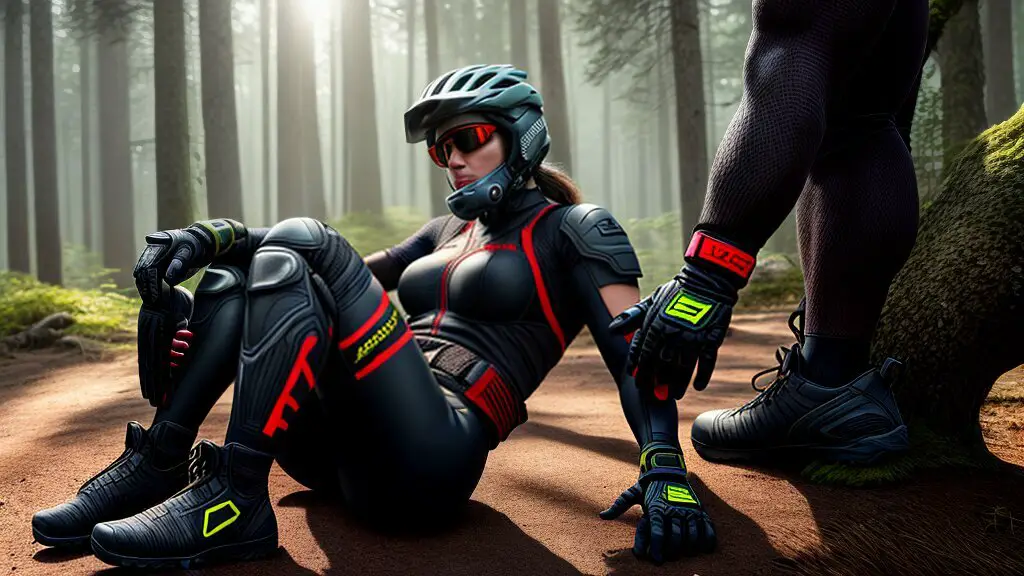
Conclusion
Congratulations! You have reached the end of our guide on how to learn to mountain bike for beginners. By following the tips and techniques outlined in this article, you can become an expert in no time.
We hope that this guide has provided you with the necessary knowledge and skills to safely and confidently tackle any mountain biking trail. Remember to always prioritize safety, wear the right equipment and gear, and gradually increase your skill level over time.
Don’t forget to explore new trails and terrains, push your limits, and most importantly, have fun! Mountain biking is a thrilling and challenging sport that can provide endless hours of enjoyment and satisfaction.
If you’re ever in doubt or need additional guidance, don’t hesitate to sign up for mountain biking classes or tutorials. Professional instructors can offer valuable insights and help you refine your skills.
Thank you for reading, and happy riding!
FAQ
Q: How can I learn to mountain bike as a beginner?
A: To learn mountain biking as a beginner, it’s important to start with understanding the fundamentals, getting the right equipment, building fitness, and mastering basic techniques. You can also join classes or tutorials to learn from experienced riders.
Q: What are the fundamentals of mountain biking?
A: The fundamentals of mountain biking include understanding bike components, body positioning, braking techniques, and balance. These fundamentals form the foundation for advanced skills and techniques.
Q: What equipment and gear do I need for mountain biking?
A: Essential mountain biking equipment and gear include a mountain bike, helmet, appropriate clothing, gloves, protective eyewear, bike repair tools, and hydration packs. It’s important to choose gear that is suitable for your riding style and the terrain you plan to ride on.
Q: How can I build my mountain biking fitness?
A: Building mountain biking fitness involves regular cardiovascular and strength training exercises. You can incorporate activities like cycling, running, hiking, and weightlifting into your training routine to improve endurance, strength, and flexibility.
Q: What are the basic mountain biking techniques I should master?
A: Basic mountain biking techniques include body positioning, cornering, braking, climbing, descending, and navigating obstacles. By practicing these techniques, you’ll become more confident and efficient on the trails.
Q: How can I develop advanced mountain biking skills?
A: Developing advanced mountain biking skills requires consistent practice and pushing your limits. Some advanced skills include jumping, drops, manualing, bunny hops, and riding technical or steep terrain. It’s important to progress gradually and always prioritize safety.
Q: How can I explore different mountain biking trails and terrain?
A: Exploring mountain biking trails and terrain involves researching and finding suitable trails in your area or while traveling. You can join local mountain biking communities or use online platforms to connect with other riders and gain insights into popular trails.
Q: Can I join mountain biking classes or tutorials?
A: Yes, joining mountain biking classes or tutorials can greatly enhance your learning experience. These classes are usually led by experienced riders or coaches who can provide guidance, tips, and structured training programs to help you improve your skills.
Q: What safety tips should I keep in mind as a mountain biking beginner?
A: As a mountain biking beginner, it’s important to wear appropriate safety gear, ride within your limits, be aware of your surroundings, follow trail etiquette, and maintain your bike regularly. It’s also advisable to ride with a buddy, inform others of your riding plans, and carry a basic first-aid kit.
Q: How can I troubleshoot common mountain biking issues?
A: Common mountain biking issues like flat tires, chain problems, braking issues, and gear shifting problems can be resolved with basic bike repair knowledge and carrying essential tools. Taking a bike maintenance course or watching online tutorials can help you become more self-sufficient in dealing with these issues.

Hi dear visitor! I’m Sebastian, a bike maniac who loves to spend a lot of time on two wheels in nature (I love white chocolate, so I absolutely need a calorie-burning balance that’s fun to boot ). Blogging is my second great passion. That’s why cyclinghalloffame.com regularly features new bike-related content.
Advertising links are marked with *. We receive a small commission on sales, nothing changes for you.
